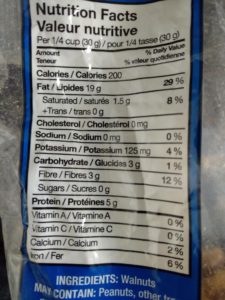Last updated on January 11th, 2024
How to Read the New Nutrition Facts Tables
The Nutrition Facts table is on the side of most packaged foods. It’s often found close to the ingredient listing. The purpose of it is to help you make better nutrition decisions. When you can see the number of calories, carbs, sodium, etc. in food, you should be able to eat better, right?
Whether you like the Nutrition Facts table or not, let’s make sure you get the most out of it, since it’s here to stay!
Here’s my 4-step crash course on reading the Nutrition Facts table.
Step 1: Serving Size
The most important part of the Nutrition Facts table is to note the serving size. Manufacturers strategically choose the serving size to make the rest of the table look good. Small serving = less calories/fat/carbs. It can often be misleading.
All the information in the table rests on the amount chosen as the serving size. Since every manufacturer chooses their own serving size, it’s often difficult to compare two products.
Over the next few years, serving sizes in Canada will become more consistent between similar foods. This will make it easier to compare foods. The new labels will also have more realistic serving sizes to reflect the amount that people actually eat in one sitting, instead of being artificially small.
Let’s use an example – plain, unsalted walnuts from Costco.
As you can see, right under the Nutrition Facts header is the serving size, which is a ¼ cup or 30 g. This means that all the numbers underneath it are based on this amount.
FUN EXPERIMENT: Try using a measuring cup to see exactly how much of a certain food equals one serving. You may be surprised at how small it is (imagine a ¼ cup of walnuts).
Step 2: % Daily Value
The % Daily Value (%DV) is based on the recommended daily amount of each nutrient the average adult needs. Ideally, you will get 100% DV for each nutrient every day. This is added up based on all of the foods and drinks you have throughout the day.
NOTE: Since children are smaller and have different nutritional needs, if a type of food is intended solely for children under the age of 4, those foods use a child’s average nutrition needs for the %DV.
The %DV is a guideline, not a rigid rule.
You don’t need to add all of your %DV up for everything you eat all day. Instead, think of anything 5% or less to be a little; and, anything 15% or more to be a lot.
NOTE: Not every nutrient has a %DV. You can see it’s missing for things like cholesterol, sugar, and protein. This is because there isn’t an agreed “official” %DV for those nutrients. The good news is that the new Nutrition Facts tables will include a %DV for sugar. Keep your eyes out for that.
Step 3: How to Read the Middle of the Nutrition Facts Table
Calories are pretty straight forward. In the example above, a ¼ cup (30 g) of walnuts has 200 calories.
Fat is bolded for a reason. That 19 g of fat (29% DV) is total fat. That includes the non-bolded items underneath it. Here, 19 g of total fat includes 1.5 g saturated fat, (19 g – 1.5 g = 17.5 g) unsaturated fat, and 0 g trans fat. (Yes, unsaturated fats including mono- and poly-unsaturated are not on the label, so you need to do a quick subtraction).
Cholesterol, sodium, and potassium are all measured in mg. Ideally, aim for around 100% of potassium and sodium each day. It’s easy to overdo sodium, especially if you grab pre-made, restaurant foods, or snacks. Keep an eye on this number if sodium can be a problem for you (e.g. if your doctor mentioned it, if you have high blood pressure or kidney problems, etc.).
Carbohydrate, like fat, is bolded because it is total carbohydrates. It includes the non-bolded items underneath it like fiber, sugar, and starch (not shown). Here, 30 g of walnuts contain 3 g of carbohydrates; that 3 g are all fiber. There is no sugar or starch. And as you can see, 3 g of fiber is 12% of your daily value for fiber.
Proteins, like calories, are pretty straight forward as well. Here, a ¼ cup (30 g) of walnuts contains 5 g of protein.
Step 4: How to Read the Bottom of the Nutrition Facts Table
The vitamins and minerals listed at the bottom of the table are also straightforward. The new labels will list potassium, calcium, and iron. Yes, potassium will drop from the middle of the table to the bottom, and both vitamins A & C will become optional.
Manufacturers can add other vitamins and minerals to the bottom of their Nutrition Facts table (this is optional). And you’ll notice that some foods contain a lot more vitamins and minerals than others do.
Conclusion
I hope this crash course in the Nutrition Facts table was helpful. While you can take it or leave it when it comes to making food decisions, it’s here to stay. And it will change slightly over the next few years. If you want to read more about the food labelling changes coming to Canada, this is a great resource.
Do you have questions about it? Have you seen the new labels with a %DV for sugar? If so, leave me a comment below.



